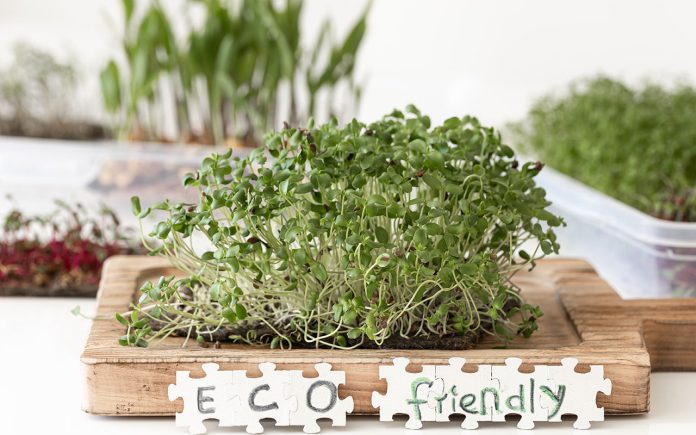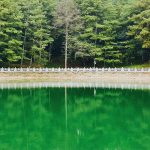Making an ecological garden requires a very different approach from making a conventional garden. The eco-friendly approach is the only, but essential difference, which ultimately marks the result in aspects such as the distribution of space, the use of recycled material, irrigation with rainwater, the use of organic seeds or, for example, the promotion of native biodiversity.
But where do you start? Once we choose the plants, whether they are organic seeds, cuttings taken from nature or plants with organic certification, we will plan the space intelligently, trying to combine their needs with an efficient use of irrigation and, if we wish, also with the ornamental effect. Keep reading this Green Ecology article if you want to know how to make an ecological garden at home.
What is an ecological garden and its characteristics
Before starting an ecological garden project, we must know its definition and characteristics. What are ecological gardens? This type of garden is characterised by letting nature itself regulate the surrounding space. In other words, chemical fertilizers or pesticides are not needed, for example.
The end result of ecological gardens translates into a reduction in damage to nature, since no artificial tools are used that can be harmful. Some of the characteristics of ecological gardens are the following:
- Inclusion of native species.
- Variety of species.
- Absence of grass.
- Young plants.
- Grouping of plants according to species and irrigation.
Now that you know what an ecological garden is and its characteristics, let’s see how to make an ecological garden at home step by step.
Sowing and fertilizing
The idea is to ensure that plants that need little watering, which at first would be the most recommended, are grouped in sunny areas, and leave the shadiest spaces for those that need more intensive watering. In this way, we will avoid wasting water and we will help the plants with the most need for water to survive the summer.
In addition, it is important to discard seasonal plants so as not to have to change them and, if possible, we will choose native species or, even better, that are also in danger of extinction.
Choosing seeds for our garden
The choice of organic seeds, on the other hand, guarantees that they have not undergone genetic modifications or alterations due to fertilizers, pesticides or other artificial treatments.
Each plant has a recommended planting time, but in general keep in mind that we will save more water by doing it in autumn, because this way they will have time to grow until the following spring and summer, so we will not have to water so much for them to grow.
Soil Type
The type of soil also influences a greater or lesser frequency of watering, as well as the fertilizer needs. It is key to know the characteristics of the soil to find out if it has good drainage and what type of compost we should create at home to compensate for deficiencies in organic matter.
If you buy the land, let’s choose the organic one. Some have worm castings and drain water in an ideal way, and pots are better made of natural clay or, why not, we recycle furniture or old objects or pallets to make original pots or planters.
Watering and pests
The drip irrigation system is suitable for sandy soils and, on the other hand, if it is clay, watering will be frequent and in small quantities. Likewise, the collection of rainwater in specific drums will be a very interesting solution for plant health and to save water.
Fighting pests without using chemicals may seem impossible. However, there are green alternatives that combat them in an ingenious way. Although there are organic products on the market, homemade tricks give a good result.
Crushing eggshells or ash and sprinkling them on the ground, making natural pesticides by mixing vinegar, onion, garlic in different proportions or covering a plant circumstantially with a thin cloth (such as those used to protect fruits), are some tricks that work.
If the situation gets out of control, we will look for organic products that are safe if applied to edible plants. On the other hand, as a prevention, strategically choosing certain types of plants that scare away one or another type of insect is also effective.
Attracting biodiversity
That’s right, fighting pests by creating a certain ecosystem, on the one hand will allow us to take advantage of the predatory function of the insects that come and thus achieve a general balance, while on the other hand we will attract wildlife.
Just as we promote native plants, it is all about attracting wildlife to our garden: squirrels, pollinating insects, beetles, small reptiles, amphibians, dragonflies, birds, etc.
The large stones piled up, the natural ponds are hiding places that amphibians and small animals will appreciate. And, of course, if we want to help our bee friends, in our garden they will find pesticide-free flowers where they can happily drink. In general, they can be attracted to any flower, just like butterflies, but we can also choose some that they particularly like.
If you want to have more details about What is biodiversity, do not hesitate to consult the following post from EcologíaVerde.
Eco-Friendly Garden Ideas
We’ve seen the steps to create an eco-friendly garden project, but you may want more specific ideas for how to do it. Here are a couple of eco-friendly garden ideas that might inspire you.
Organic vegetable garden
If the garden is spacious, a very popular alternative idea with great benefits is the planting of a vegetable garden. Organic farming that will improve the garden as a whole and our quality of life. For this task you can use:
- A square base
- A large planter
- Delimit a space with wooden stakes or glass bottles with the base facing up
It is important to place the garden away from trees that take away the water and avoid walls that can avoid the sun’s rays. When distributing it we will have to take into account the exposure to the sun:
- In the sunniest part: tomatoes, peppers and fruits.
- In the darkest part: vegetables such as lettuce, spinach, broccoli or beans.
Each type of plant requires its own water level, sun exposure, and self-care. To rid vegetables of pests, the aforementioned aromatic plants can also be grown. Keep in mind that, during the winter, we will need adequate protection against wind or low temperatures.
The soil should be well removed before planting and enriched with homemade compost so that organic products grow more natural and tasty. In the long run, it has been proven that the organic urban garden is a savings and the quality of the fruits and vegetables is usually exceptional.
Ecological gardens for wild species
Other proposals to consider for your ecological garden are: promote the wildlife of birds and other species by adding attractions such as:
- Drinkers
- Ponds
In addition, we can also have various types of trees, use biodegradable pots or, failing that, the bottom of plastic bottles, the integration of kokedama plants (a ball of moss covering the roots that replaces the pot) and keep the grass longer to avoid the excessive use of lawn mowers.
Benefits of Organic Gardens
An organic garden automatically controls insect pests, breaking the habit of exterminating all kinds of living beings that we encounter. Some, such as bees or centipedes, feed on minor parasites, which do have a negative impact on plants, so letting them live respects the micro habitat of our garden.
In the event that we are forced to act against a certain pest, insecticides can be made from garlic or tomato that do not use any chemical compound. An ecological garden is therefore erected as a more natural space.
Other benefits of organic gardens are the use of water and light sources, the non-extermination of insects and the natural feeding of the substrate. They also combat global warming and the effects it implies, as well as promoting local commerce.
If you want to read similar articles to How to make an ecological garden, we recommend that you visit our Garden Care category.










